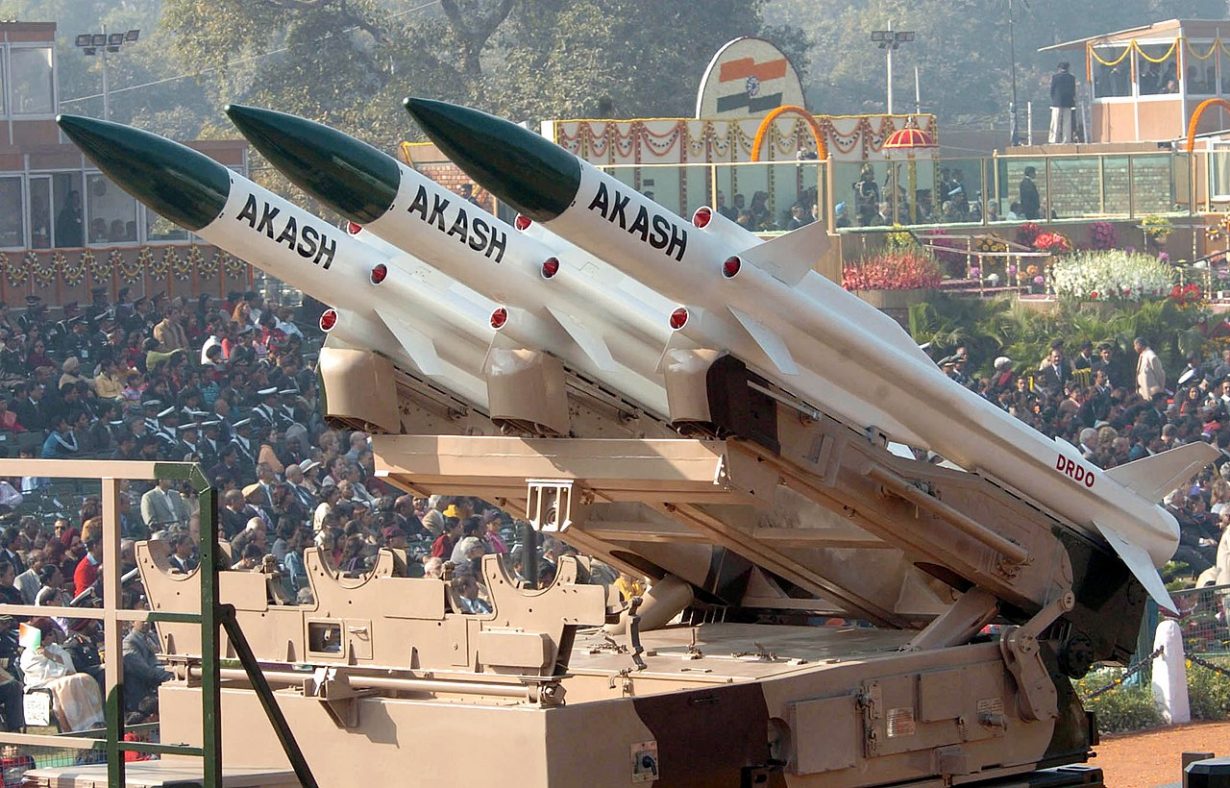Pushing the limits of its indigenously developed surface-to-air missile (SAM) system, the Indian Army conducted yet another test of its medium-range missile Akash (sky) in late March.
Myanmar Rebels Puncture India’s Development of Sittwe Port; Experts Blame China-Backed Arakan Army
The indigenous Akash missile was successfully tested by the Indian Army’s Western Command, enhancing the capabilities of the country’s ground forces and providing a boost to India’s “Atmanirbhar” (self-reliance) program, which seeks to expand indigenous development and manufacturing of military equipment.
The Indian Army’s Western Command took to Platform X to announce the success of its test with hashtags indicating that the system boasts of accurate target engagement and formidable firepower. The missile was reportedly test-fired against unmanned aerial targets.
Although the Indian Army did not publish specific details, military expert Squadron Leader Vijainder Thakur (Retd) speculated that the missile in question was the Akash 1S missile, a new variant.
#SkyGladiators#ArmyAirDefence#DefendersOfPunjab#AkashMissile System #Accurate target engagement capability and formidable #Firepower.#DeadlyAndLethal@adgpi@SpokespersonMoD pic.twitter.com/fLYy09gNwG
— Western Command – Indian Army (@westerncomd_IA) March 30, 2024
This new variant, which is several times more capable than the previous one, was first test-fired in 2019. EurAsian Times could not independently verify the expert’s conjectures.
Thakur said: “While yet to be operationally proven, the Akash missile gives Indian armed forces a potent capability that can not only address current threats but also be progressively honed to neutralize aerial threats far into the future!”
Owing to their versatile deployment capabilities, Akash missiles can be fired from both stationary and mobile platforms, including combat tanks and wheeled trucks. It is capable of taking down a variety of targets and maneuvering around them, such as fighter planes, unmanned aerial vehicles (UAVs), cruise missiles, and missiles fired from helicopters.
The missile can destroy aircraft up to a height of 18,000 meters and has a range between 30 and 35 kilometers. It provides multidirectional and multitarget area defense, and more importantly, it is capable of transporting up to 60 kilograms of nuclear and conventional weapons.
The missile can destroy planes and warheads fired by ballistic missiles since it has a nuclear warhead integrated into it. It functions in any type of weather. While the missile has not been used in combat, its capabilities are promising when faced against adversaries across its borders in the north and the west.
#WATCH DRDO yesterday successfully test fired the Akash-1S surface to air defence missile system in Balasore off the Odisha coast. It is a new version of the missile fitted with an indigenous seeker. It was the second successful test of the missile. pic.twitter.com/XuaHTTC46F
— ANI (@ANI) May 28, 2019
The Akash Weapon System (AWS) is being inducted into the Indian Army as a Short-Range Surface Air Missile (SRSAM) system. This is the first India-developed SAM with an indigenous Radio Frequency (RF) seeker, as explained in a previous EurAsian Times report.
The Akash-1 missile is way more lethal as it uses command guidance without terminal homing. Command guidance is jam-resistant because a powerful ground-based radar does target tracking but becomes progressively inaccurate with an increase in range.
At the end of the engagement, when ground-based target and missile tracking resolution is at its lowest point (about 30 kilometers for Akash), there is little chance of a successful intercept.
During the first part of the flight, the AWS keeps the Akash-1’s jam-proof command guiding capabilities, but during the final stretch, it activates its Radio Frequency or active seeker. The missile has a higher chance of success at longer ranges when it has a seeker lock.
The effectiveness of short-range missiles in intercepting moving targets is limited because they usually experience motor burnout as they draw closer to their limiting range. However, the Akash-1S is powered by a ramjet.
In addition to being an active seeker, the missile has a smaller footprint, 360-degree engagement capability, and capacity to function in harsh settings.
Even in its basic variant, Akash has managed to hog the global limelight. This domestically-built system has also emerged as a poster child of India’s defense export ambitions, especially with the latest deal with Armenia that has grabbed many eyeballs worldwide.

Akash For Armenia
Armenia has become one of India’s principal importers of armaments. Reports are rife that the nation is set to acquire the Akash surface-to-air missile (SAM) as it tries to diversify its military imports in the wake of Russia’s inability to deliver equipment on schedule.
Russia Stunned By NASA’s Role In Ukraine War; Claims Tech From Mars Mission Found In Ukrainian UAVs
Armenia’s interest hinges on the fact that the system is highly immune to active and passive jamming, that it is easily deployable, and can move fast by road or rail. It is anticipated that by 2026-2027, the project’s entire indigenous content will rise to 93%.
For Yerevan’s need to counter Azerbaijan’s armed drones, Akash is the perfect weapon because of its versatility and capacity to take down moving targets like cruise missiles, unmanned aerial vehicles (UAVs), and missiles fired from helicopters.
Armenia has also purchased indigenous Pinaka multi-barrel rocket launchers, Konkurs anti-tank guided missiles, and a wide variety of ammunition, including 80-mm mortars, to counter Azerbaijan. The EurAsian Times had earlier reported that after importing rocket launchers and missiles from India, Armenia was importing an anti-drone system.
The constant upgrades to the system by India and the newer variants, like the Akash-1S or the next-generation Akash, bolsters its export potential.
- Contact the author at sakshi.tiwari9555 (at) gmail.com
- Follow EurAsian Times on Google News




